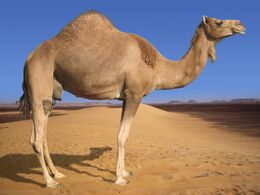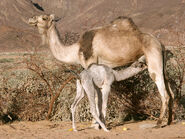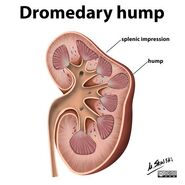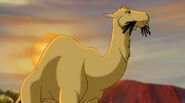
The dromedary, also called the Arabian camel (Camelus dromedarius), is a large, even-toed ungulate with one hump on its back. Greek philosopher Aristotle (4th century BCE) was the first to describe the species, and the animal was given its current binomial name by Carl Linnaeus, a Swedish zoologist. The dromedary is the largest camel after the Bactrian camel. Adult male dromedaries stand 1.8–2 m (5.9–6.6 ft) at the shoulder, while females are 1.7–1.9 m (5.6–6.2 ft) tall. The weight typically ranges from 400–600 kg (880–1,320 lb) in males and 300–540 kg (660–1,190 lb) in females. The distinctive features of this camel are its long curved neck, narrow chest and only one hump (compared to the two on the Bactrian camel), thick double-layered eyelashes and bushy eyebrows. The coat is generally a shade of brown, but can range from black to nearly white. The hump, which can be 20 cm (7.9 in) tall or more, is made up of fat bound together by fibrous tissue.
Their diet includes foliage and desert vegetation, like thorny plants which their extremely tough mouths allow them to eat. These camels are active in the day, and rest together in groups. Led by a dominant male, each herd consists of about 20 individuals. Some males form bachelor groups. Dromedaries show no signs of territoriality, as herds often merge during calamities. Predators in the wild include wolves and lions; and tigers in the past. Dromedaries use a wide set of vocalizations to communicate with each other. They have various adaptations to help them exist in their desert habitat. Dromedaries have bushy eyebrows and two rows of long eyelashes to protect their eyes, and can close their nostrils to face sandstorms. Their ears are also lined with protective hair. When water-deprived, they can fluctuate their body temperature by 6 °C, changing from a morning minimum of 34° to a maximum of 40° or so in the afternoon. This reduces heat flow from the environment to the body and thereby water loss through perspiration is minimised. They have specialized kidneys, which make them able to tolerate water loss of more than 30% of their body mass; a loss of 15% would prove fatal in most other animals. Mating usually occurs in winter, often overlapping the rainy season. One calf is born after the gestational period of 15 months, and is nurtured for about two years.
Taxonomy and Classification[]
The dromedary shares the genus Camelus with the Bactrian camel (C. bactrianus) and the wild Bactrian camel (C. ferus). The dromedary belongs to the family Camelidae. The ancient Greek philosopher Aristotle (4th century BC) was the first to describe the species of Camelus. He named two species in his History of Animals: the one-humped Arabian camel and the two-humped Bactrian camel. The dromedary was given its current binomial name Camelus dromedarius by Swedish zoologist Carl Linnaeus in his 1758 publication Systema Naturae. In 1927, British veterinarian Arnold Leese classified dromedaries by their basic habitats: the hill camels, small muscular animals and efficient beasts of burden; the larger plains camels, that could be further divided into the desert type (that can bear light burden and are apt for riding) and the riverine type (slow animals that can bear heavy burden); and those intermediate between these two types.
In 2007, Peng Cui (of the Chinese Academy of Sciences) and colleagues carried out a phylogenetic study of the evolutionary relationships between the two tribes of Camelidae: Camelini - consisting of the three Camelus species (the study considered the wild Bactrian camel as a subspecies of the Bactrian camel) - and Lamini - consisting of the alpaca (Vicugna pacos), the guanaco (Lama guanicoe), the llama (L. glama) and the vicuña (V. vicugna). The study revealed that the two tribes had diverged 25 million years ago (early Miocene), notably earlier than what had been previously estimated from North American fossils. Speciation began first in Lamini as the alpaca came into existence 10 million years ago (late Pleistocene). Nearly two million years later, the dromedary and the Bactrian camel emerged as two independent species.
The dromedary and the Bactrian camel often interbreed to produce fertile offspring. Where the ranges of the two species overlap, such as in northern Punjab, Persia and Afghanistan, the phenotypic differences between them tend to decrease as a result of extensive crossbreeding between them. The fertility of their hybrid has given rise to speculation that the dromedary and the Bactrian camel should be merged into a single species with two varieties. However, a 1994 analysis of the mitochondrial cytochrome b gene revealed that the species display 10.3% divergence in their sequences.
Characteristics[]
The dromedary is the largest camel after the Bactrian camel. Adult male dromedaries stand 1.8–2 m (5.9–6.6 ft) at the shoulder, while females are 1.7–1.9 m (5.6–6.2 ft) tall. The weight typically ranges from 400–600 kg (880–1,320 lb) in males and 300–540 kg (660–1,190 lb) in females. The distinctive features of this camel are its long curved neck, narrow chest and a single hump (compared to the two on the Bactrian camel), thick double-layered eyelashes and bushy eyebrows. These camels have a sharp vision and a good sense of smell. The male has a soft palate (dulaa in Arabic), nearly 18 cm (7.1 in) long, which he inflates to produce a deep pink sac. Often mistaken for the tongue, the palate dangles out from a side of the male's mouth to attract females during the mating season.
The coat is generally a shade of brown, but can range from black to nearly white. Leese reported piebald dromedaries from Kordofan and Darfur in Sudan. The hair is long and concentrated on the throat, shoulders and the hump. The eyes are large and protected by prominent supraorbital ridges; the ears are small and rounded. The hump is at least 20 cm (7.9 in) high. The dromedary has long and powerful legs with two toes on either feet. The feet resemble flat, leathery pads. This camel moves both legs on one side of the body at the same time, like the giraffe.
Unlike the Bactrian camel, the dromedary has a lighter build, longer limbs, shorter hairs, a harder palate, and an insigificant or absent ethmoidal fissure. The dromedary differs from the camelids of the genus Lama in possessing a hump, a longer tail, smaller ears, squarer feet and reaching a greater height at the shoulder. Moreover, the dromedary has four teats instead of the two in the Lama species.
Anatomy[]
The cranium of the dromedary consists of a postorbital bar, a tympanic bulla (filled with spongiosa), a well-defined sagittal crest, a long facial part and an indented nasal bone. Typically, there are eight sternal and four non-sternal pairs of ribs. The spinal cord, nearly 214 cm (84 in) long, terminates in the second and third sacral vertebra. The fibula is reduced to a malleolar bone. A digitigrade animal, the dromedary walks on its toes or digits. It lacks the second and fifth digits. The front feet, 19 cm (7.5 in) wide and 18 cm (7.1 in) long, are larger than the hind feet, 17 cm (6.7 in) wide and 16 cm (6.3 in) long.
The dromedary has 22 milk teeth, which are eventually replaced by 34 permanent teeth. The dental formula for permanent dentition is 1.1.3.33.1.2.3, and 1.1.33.1.2 for milk dentition. The juvenile develops the lower first molars by 12 to 15 months, but the permanent lower incisors appear only at 4.5 to 6.5 years of age. All teeth are in use by the age of 8 years. The lenses of the eyes contain crystallin, which constitutes 8 to 13% of the total protein present there.
The skin is basically black; the epidermis is 0.038–0.064 mm (0.0015–0.0025 in) thick, while the dermis is 2.2–4.7 mm (0.087–0.185 in) thick. The hump is composed of fat bound together by fibrous tissue. Though glands are absent on the face, males have glands on either side of the midline of the neck. These appear to be modified apocrine sweat glands which secrete a pungent, coffee-coloured fluid during the rut. The weight of these glands generally increases during the rut, and ranges from 20 to 115 g (0.71 to 4.06 oz). Each cover hair is associated with an arrector pilli muscle, a hair follicle, a ring of sebaceous glands and a sweat gland. Females have cone-shaped, four-chambered mammary glands, 2.4 cm (0.94 in) long with a base diameter of 1.5 cm (0.59 in). An interesting feature of these glands is that they can produce milk with the water content as high as 90% even if the mother is at risk of dehydration.
The heart, 5 kg (11 lb) heavy, has two ventricles with the tip curving to the left. The pulse rate is 50 beats per minute. The normal blood volume of the dromedary is 0.093 l (0.020 imp gal). The dromedary is the only mammal with oval red blood corpuscles. The pH of the blood varies from 7.1 to 7.6 (slightly alkaline). The state of hydration and the sex of the animal and the season can influence blood values. The lungs lack lobes. A dehydrated camel has a lower breathing rate. Either kidney has a volume of 858 cm3 (52.4 cu in), and can produce urine with high chloride concentrations. Like the horse, the dromedary lacks a gall bladder. The grayish violet, crescent-like spleenweighs less than 500 g (18 oz). The triangular, four-chambered liver weighs 6.5 kg (14 lb); its dimensions are: 60×42×18 cm (23.6×16.5×7.1 in).
The ovaries, present in females, are reddish, circular and flattened. They are enclosed in a conical bursa, and have the dimensions 4×2.5×0.5 cm (1.57×0.98×0.20 in) during anestrus. The oviducts are 25–28 cm (9.8–11.0 in) long. The uterus is bicornuate. The vagina, 3–3.5 cm (1.2–1.4 in) long, has well-developed Bartholin's glands. The vulva is 3–5 cm (1.2–2.0 in) deep with a small clitoris. The placenta is diffuse and epitheliochorial, with a crescent-like chorion. The penis, covered by a triangular penile sheath that opens backward, is about 60 cm (24 in) long. The scrotum, present in males, is located high in the perineum with the testicles in separate sacs. Testicles are 7–10 cm (2.8–3.9 in) long, 4.5 cm (1.8 in) deep and 5 cm (2.0 in) wide. The right testicle is often smaller than the left. The typical mass of either testicle is less than 140 g (0.31 lb); however, the mass increases during the rut, ranging from 165 to 253 g (0.364 to 0.558 lb). The Cowper's gland is white, shaped like an almond, and lacks seminal vesicles; the prostate gland is dark yellow, disc-shaped and divided into two lobes.
Ecology[]
The dromedary is diurnal (active mainly during the daytime); free-ranging herds feed and roam throughout the day, though they rest during the hot noon hours. The night is mainly spent in resting. Dromedaries form cohesive groups of about 20 individuals, led by a dominant male and consisting of several females. Females may also lead in turns. Some males either form bachelor groups or roam alone. Herds may congregate to form associations of over hundreds of camels during migrations at the time of natural calamities. The males of the herd prevent the female members from interacting with other bachelor males by standing or walking between them and might drive them away. Short-term home ranges of the feral camels in Australia are 50–150 km2(19–58 sq mi) in area; annual home ranges could spread over several thousand square kilometres.
Some special behavioural features of the camel include snapping at other camels without biting them and showing displeasure by stamping their feet. They are generally non-aggressive, with the exception of rutting males. Camels apparently remember their homes; females in particular remember the place they first gave birth or suckled their offspring. Males turn aggressive in the mating season, and might even wrestle. A 1980 study showed that androgen levels in males influences their behaviour. Between January and April, when these levels are high due to the rut, they become difficult to manage, blow out the palate from the mouth, vocalise, and throw urine over their back. Camels scratch parts of their bodies with their front or hind legs or with their lower incisors. They may also rub against tree bark and roll in the sand. Free-ranging dromedaries face the large predators typical of their regional distribution, which includes wolves, lions and tigers.
Diet[]
The diet of the dromedary mostly consists of foliage, dry grasses, and available desert vegetation (mostly thorny plants) growing in the camel's natural habitat. A study gave the following composition of the typical diet of the dromedary: dwarf shrubs (47.5%), trees (29.9%), grasses (11.2%), other herbs (0.2%) and vines (11%). The dromedary is primarily a browser, with forbs and shrubs comprising 70% of their diet in summer and 90% in winter. The dromedary may also graze on, or suck in, tall young succulent grasses.
In the Sahara, 332 plant species have been recorded for the dromedary. These include Aristida pungens, Acacia tortilis, Panicum turgidum, Launaea arborescens and Balanites aegyptiaca. The dromedary will feed on Acacia, Atriplex, and Salsola plants whenever available. The feral dromedaries in Australia prefer Trichodesma zeylanicum and Euphorbia tannensis. In India dromedaries are fed with forage plants such as Vigna aconitifolia, V. mungo, Cyamopsis tetragonolaba, Melilotus parviflora, Eruca sativa, Trifolium species and Brassica campestris. The dromedaries keep their mouths open while chewing thorny food. They use their lips to grasp the food, then chew each bite 40-50 times. Features like long eyelashes, eyebrows, lockable nostrils, caudal opening of the prepuce and a relatively small vulva help the camel avoid injuries, especially while feeding. They graze for 8–12 hours per day and ruminate for an equal amount of time.
Adaptations[]
he dromedary is specially adapted to their desert habitat; these adaptations are aimed to conserve water and regulate body temperature. The bushy eyebrows and the double row of eyelashes prevent sand and dust from entering the eyes during strong winds characteristic of deserts, and shield the eyes from the sun's glare. The dromedary is able to close its nostrils voluntarily; this assists in water conservation. The dromedary can conserve water by reducing perspiration, which it achieves by fluctuating the body temperature throughout the day from 31 to 41.7 °C (87.8 to 107.1 °F). The kidneys are specialised to minimise the loss of water through excretion. Groups of camels also avoid excess heat from the environment by pressing against each other. The dromedary can tolerate greater than 30% water loss, which is generally not possible for other mammals. In temperatures ranging from 30 to 40 °C (86 to 104 °F), it needs water every 10 to 15 days; only in the hottest temperatures does the dromedary take water every four to seven days. This camel has a fast rate of rehydration and can drink at the speed of 10–20 L (2.2–4.4 imp gal) per minute. The dromedary has a rete mirabile, a complex of arteries and veins lying very close to each other which use countercurrent blood flow to cool blood flowing to the brain–this is effective in controlling the temperature of the brain.
The hump stores up to 80 lb (36 kg) of fat, which the camel can break down into water and energy to meet its needs when resources are scarce; the hump also helps dissipate body heat. If the hump is small, the animal can show signs of starvation. In a 2005 study, the mean volume of adipose tissues (in the external part of the hump that have cells to store lipids) is related to the dromedary's unique mechanism of food and water storage. In case of starvation, they can even eat fish and bones, and drink brackish and salty water. The hair is longer on the throat, hump and shoulders. Though the padded effectively support the camel's weight on the ground, they are not suitable for walking on slippery and muddy surfaces.
Reproduction[]
Since camels have a slow growth rate, they reach sexual maturity only in advanced years. This age varies geographically and also depends on the individual, as does the reproductive period of their life. Females reach sexual maturity typically around three years of age and mate around age four or five. Males begin to mate at around three years of age, too, but still are not sexually mature until six years of age. Mating occurs once a year, and peaks in the rainy season. The mating season lasts three to five months, but may even last a year for older animals.
During the reproductive season, males splash their urine on their tails and nearer regions. Males extrude their soft palate to attract females - a trait unique to the dromedary. Copious saliva turns to foam as the male gurgles, covering the mouth. Males threaten each other for dominance over the female by trying to stand taller than the other, making low noises and a series of head movements including lowering, lifting, and bending their necks backwards. A male tries to defeat other males by biting at his legs and taking the opponent's head in between his jaws. Copulation begins with a necking exercise. The male smells the female's genitalia, and often bites her in that region or around her hump. The male makes the female sit, and then grasps her with his forelegs. The camelmen often aid the male to enter his penis into the female's vulva. It is disputed whether the male dromedary can penetrate the female on his own or not. Copulation time ranges from 7 to 35 minutes, averaging 11 to 15 minutes. Normally, three to four ejaculations occur. The semen of a Bikaneri dromedary was found to be white and viscous, with a pH of around 7.8.
A single calf is born after a gestational period of 15 months. Calves move freely by the end of their first day. Nursing and maternal care continue for one to two years. In a study to find whether young could exist on milk substitutes, two male young camels, one month old, were separated from their mothers and were fed on milk substitutes prepared commercially for lambs. For the initial 30 days, the changes in their weights were marked. Each gained 0.400 kg (0.88 lb) and 1 kg (2.2 lb), respectively, per day. Finally, they were found to have grown properly and weighed normal weights of 135 kg (298 lb) and 145 kg (320 lb). Lactational yield can vary with species, breed, individual, region, diet, management conditions and lactating stage. Maximum milk is produced during the early period of lactation. The length of the lactation period can vary from nine to eighteen months.
Dromedaries are induced ovulates. Oestrus might be cued by nutritional status of the camel and the day length. If mating does not occur, the follicle, which grows during estrus, usually regresses within a few days. In one study, 35 complete estrous cycles were observed in five nonpregnant females over a period of 15 months. The cycles were about 28 days long, in which follicles matured in six days, maintained their size for 13 days, and returned to their original size in eight days. In another study, ovulation could be best induced when the follicle reaches a size of 0.9–1.9 cm (0.35–0.75 in). In another study, pregnancy in females could be recognized as early as 40 to 45 days of gestation by the swelling of the left uterine horn, where 99.52% of pregnancies were located.
Domestication[]
The dromedary was first domesticated probably in Somalia or the Arabian Peninsula about 4000 years ago. In the ninth or tenth century BCE, the dromedary became popular in the Near East. The Persian invasion of Egypt under Cambyses in 525 BCE introduced domesticated camels to the area. The Persian camels, however, were not particularly suited to trading or travel over the Sahara; journeys across the desert were made on chariots pulled by horses. The dromedary was introduced into northern Africa (Egypt) from southwestern Asia (Arabia and Persia). The popularity of dromedaries got the next major boost after the Islamic conquest of North Africa. While the invasion was accomplished largely on horseback, the new links to the Middle East allowed camels to be imported en masse. These camels were well-suited to long desert journeys and could carry a great deal of cargo, allowing substantial trade over the Sahara for the first time. In Libya, they were used for transportation within the country, and their milk and meat constituted the local diet.
Individuals were also shipped from southwestern Asia to Spain, Italy, Turkey, France, Canary Islands, the Americas and Australia. Dromedaries were introduced into Spain in 1020 AD and to Sicily in 1059 AD. Dromedaries had also been exported to the Canary Islands in 1405 AD, during the times of European colonisation of the area, and still exist, particularly in Lanzarote and to the south of Fuerteventura. Attempts had been made to introduce dromedaries into the Caribbean, Colombia, Peru, Bolivia, and Brazil between the 17th and the 19th centuries; some were imported to the western United States in the 1850s and some to Namibia in the early 1900s, but presently they exist in small numbers or are absent in these areas.
In 1840, about six camels were shipped from Tenerife to Adelaide, but only one survived through the trip, reaching the destination on October 12 that year. The animal, a male, was called Harry and was owned by the explorer John Ainsworth Horrocks. Although Harry had proved to be bad-tempered, he was included in an expedition in the following year because he could carry heavy loads. The next major group of camels were imported in 1860 and between 1860 and 1907 some 10 to 12 thousand were imported. These were used mainly for riding and transportation.
























